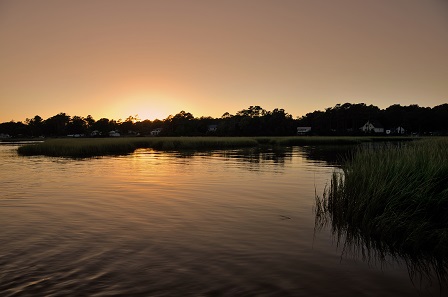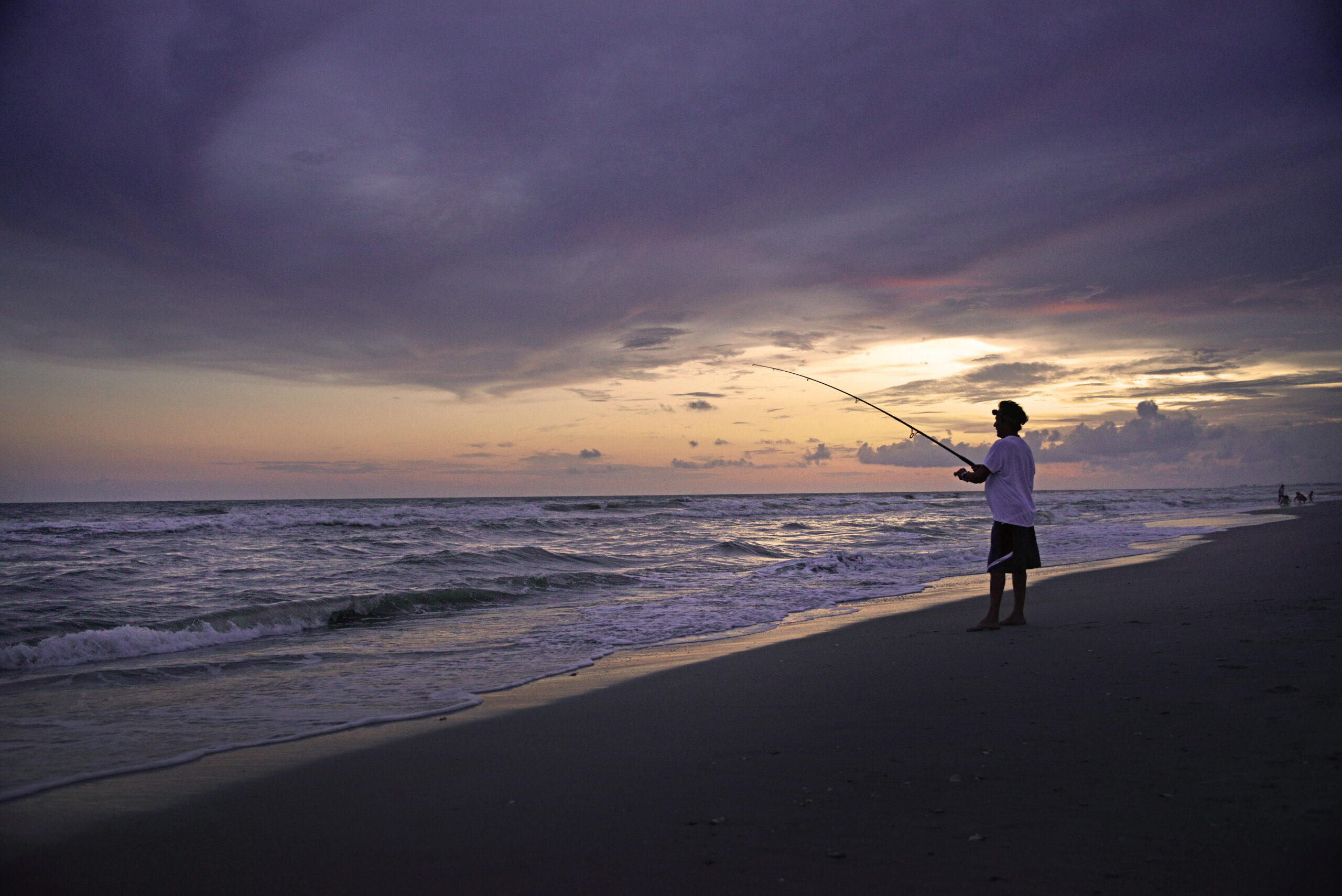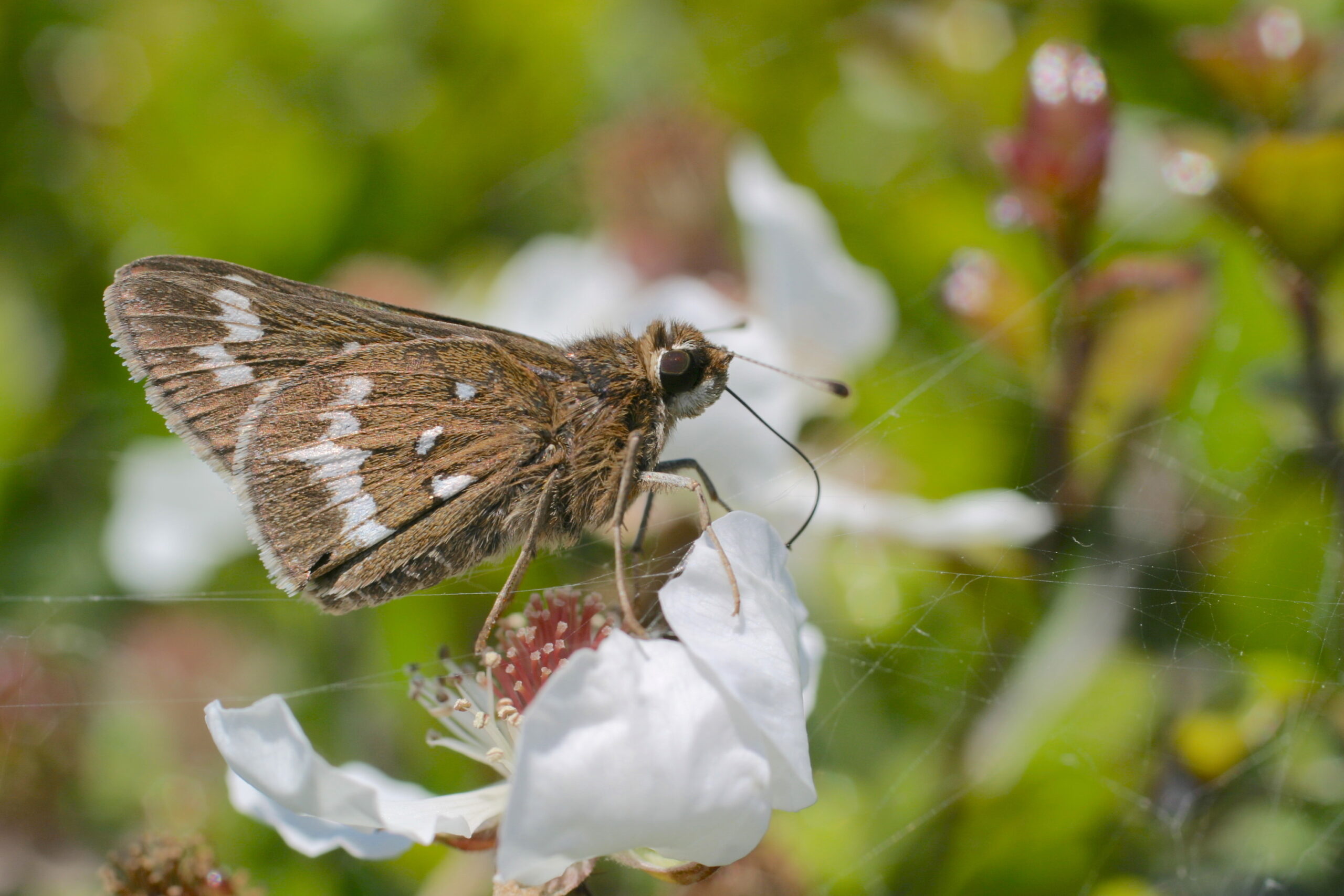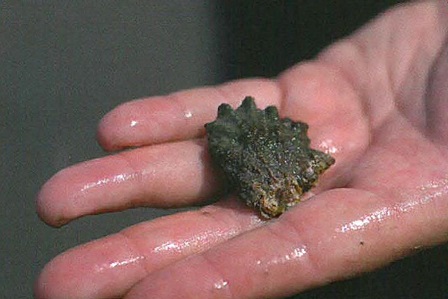Finding Flounder: Testing Low-Profile Gill Nets

Charlie Van Salisbury is setting his nets where very few have been allowed to go since 2000: the flounder-rich, deep-water area of the Pamlico Sound.
Well before sunrise, the Engelhard resident is already at work in the sound’s choppy waters. He removes an orange and black buoy attached to the end of one of his gill nets and reels it in with the white winch on his boat.
Van Salisbury uses a digging motion to untangle flounder and bycatch from his nets — including rays and skates, horseshoe crabs and one sheepshead fish. Bob Hines, a North Carolina Sea Grant fisheries specialist and first mate for the day, helps Van Salisbury sort the catch.
Flounder are passed to Paula Gillikin, an N.C. Division of Marine Fisheries (DMF) observer, to measure and count. She tosses back undersized fish. Legal-sized fish end up in plastic buckets that are later weighed and emptied into a large blue plastic covered tub.
Due to an increase in sea turtle strandings and subsequent observed sea turtle interactions with gill nets, the National Marine Fisheries Service (NMFS) permanently closed the deep-water area of the Pamlico Sound to large-mesh gill net commercial fishing from September to mid-December — previously the main flounder season — in 2002. This closure followed emergency closures between 1999 and 2001. Entangled turtles can drown in the nets, sustain grave injuries or experience life-threatening stress.
These reptiles are found in estuarine waters throughout North Carolina from April through September, migrating from the sound towards warmer water in autumn.
“At the start of the water temperature drop, turtles start flushing out of the sound,” says Blake Price, fishery biologist for DMF and an advisor to N.C. Marine Fisheries Commission’s (MFC) Sea Turtle Bycatch Advisory Committee. The start of fall migration around September coincides with the beginning of flounder fishing season in the shallow-water and the now-closed deep-water areas of the Pamlico Sound.
Van Salisbury, Lyle Cahoon, Larry Gill, Teddy Gibbs and Derek Noble are participating in an N.C. Fishery Resource Grant (FRG) study funded by the N.C. General Assembly and administered by North Carolina Sea Grant. These Hyde County fishermen use experimental nets designed to produce a good flounder catch yet avoid or significantly reduce sea turtle entanglements. If successful, these new nets might allow a limited re-opening of the deep-water area of the Pamlico Sound.
“If they let us back,” says Van Salisbury, “it’ll be like Christmas.”
Sea Turtles and the ESA
The waters in and around North Carolina are home to several species of sea turtles, most commonly the threatened loggerhead, Caretta caretta. All sea turtles in U.S. waters are considered either threatened or endangered. They are protected under the federal Endangered Species Act (ESA), which Congress passed to protect and recover the nation’s natural resources and ecosystems.
An endangered species is in danger of becoming extinct throughout all or a significant part of its natural habitat or range. A threatened species could potentially become endangered soon.
“It is prohibited for anybody to take any listed species, even incidentally,” says David Bernhart, the assistant regional administrator for protected resources with NMFS in St. Petersburg, Fla.
A “take” is a “means to harass, harm, pursue, hunt, shoot, wound, kill, trap, capture, or collect, or to attempt to engage in any such conduct” towards a protected species. Incidental, or accidental, interactions are not exempt under the ESA.
However, Congress allows some exceptions to the take of protected species through Section 7 permits, which allow incidental take due to federal activities. Section 10 permits allow the intentional take of the protected species for scientific research of that species, or incidental take during otherwise lawful activities such as fishing.
North Carolina has two different Section 10 permits that allow a certain threshold of incidental takes in the Pamlico Sound. One permit allows fishing in the shallow-water region of the sound, while the other is for the FRG research. If incidental takes exceed the permitted threshold, DMF must close the area.
“We want to identify a gear that would be allowed to be used in this area,” Price says. He hopes to find a net that reduces or eliminates sea turtle entanglements while maintaining a high flounder catch. With the help of Van Salisbury, Price has tested different gill net configurations in the Pamlico Sound since 2001. The current FRG study is the third iteration.
The first study involved two nets, one net that did not catch enough fish and another that did Van Salisbury and Price focused on the successful net in the next trial. This final test has five fishermen comparing the successful experimental design with traditional nets between September and November.
“We wanted to expand [the test] to multiple fishermen and a bigger geographic area” to validate the results and determine the usefulness of the gear, Price explains.
Net Design
Gill nets are a controversial gear. Many opponents argue that gill nets indiscriminately entangle everything — protected or otherwise — that swims by.
“Gill nets are death for sea turtles,” says Jean Beasley, director of the Karen Beasley Sea Turtle Rescue and Rehabilitation Center on Topsail Island.
A typical large-mesh gill net used in this area of the Pamlico Sound has six-inch stretch mesh — the height of one mesh pulled taut — and is 25 meshes deep.
“A traditional gill net is a vertical wall of webbing 12 feet tall,” Price says.
The net has a float line — also called the top or head line — with evenly spaced floats, and a lead line with weights at the bottom. The float and lead lines allow the gill net to be suspended in the water.
Every 30 to 36 feet along the net, three- to four-foot lines gather and shrink the 12-foot netting. These tie-downs create a “bag” effect that is supposed to increase the flounder catch. Unfortunately, many sea turtles get entangled in the bags too.
However, Van Salisbury, a member of the MFC’s sea turtle committee, and Price believe that the experimental net will entangle fewer sea turtles. It is half as high as a traditional net with six-inch stretch mesh 12 meshes deep. There no flotation along the top line and no tie-downs.
“The low-profile nets eliminate the bag — and fishes less of the water column,” Price explains. “It greatly reduces the probability of entanglement of sea turtles.”
The smaller nets also are easier to get bain the water. “Less webbing means less chaix. to rip the net on the net reel when setting the gear out,” notes DMF observer Gillikin.
This experimental net has to catch enough fish to make it worth fishing while reducing sea turtle entanglement. Price estimates that the experimental nets are catching roughly 60 percent as much as the traditional nets. A 60 to 75 percent catch rate compared to traditional nets would likely be “completely acceptable” to the industry, he predicts.
Price believes that, even if the NMFS reopens the Pamlico Sound, regulators would limit the low-profile net to 2,000 yards, which is the yardage limit on the sound’s shallow-water fishery.
“The nets are catching well,” says Van Salisbury, who is pleased with the catch and the lack of bycatch. Less bycatch allows him to clean out his nets faster and lowers fishing effort per net.
Derek Noble, a study member, is a bit more guarded. “I would use it if I could get enough yardage,” he says. He estimates that less than 4,000 yards would not be a worthwhile investment. According to Noble, the low-profile nets are catching about half of what the traditional nets would, an insufficient haul to justify his initial expenditures.
Lyle Cahoon, another study participant, also would want to use more yardage before he would fish commercially with the experimental nets. However, Cahoon notices an advantage of these new nets: “I fish them faster because there is less bycatch.”
Although the experimental nets caught no sea turtles in both previous tests, one live and two dead sea turtles were found in them in fall 2006. During the current study, four live and two dead sea turtles were found in the traditions gill nets.
Closing the Sound
Between Nov. 1 and Dec. 4, 1999, 74 sea turtles stranded in Hatteras and Ocracoke inlets.
The standings were “remarkably higher than anything we’d seen before,” NMFS’ Bernhart recalls, including 39 Kemp’s ridleys, which are “the most endangered in terms of numbers.” Standings are events where sea turtles, alive or dead, wash ashore or are found floating.
In 2000, NMFS and DMF observers also saw several interactions between the sea turtles and deep-water gill netters, considered a possible culprit in the mass standings.
These events prompted NMFS regulators to declare emergency closures of the Pamlico Sound to gill netting in 2000 and 2001, and a permanent closure in 2002.
By the 2000 closure, Van Salisbury had seen the gill net fishery in the Pamlico Sound surpass the long-established pound net fishery along the sound’s banks. The gill net fishery had grown from three boats, each using about 2,000 yards of gill net in 1994 to 32 boats, each with about 8,000 yards of gill net.
Each boat had a captain and a mate, Van Salisbury notes. “The closure affected 64 families.”
“Maybe if something was done back then, maybe this wouldn’t have happened,” he muses.
Many commercial fishing crews in Hyde County lost a significant source of fall income when the flounder fishery in the sound was closed.
“The closure was a big deal for the fishermen and fish houses,” says David Hilton, who fishes in the Outer Banks. He was formerly an MFC member and, earlier, on the sea turtle committee. “It’s a morale issue. Fishermen don’t know where to sell or where to catch,” a demoralizing and frustrating position.
When NMFS closed the sound in 2000, regulators expected that many gill netters would be able to switch to other fisheries, estimating that each vessel would have an overall loss of $10,000 to $20,000 annually.
However, finding new fisheries was not so easy for some.
The closure of the Pamlico Sound forced Noble to sell almost everything he owned — “pots, boats, nets.” He made a living harvesting crabs and oysters from the surrounding waters.
“I haven’t fished for a couple of years until this project,” he says.
“It practically ruined us,” Cahoon says. The closure of the Pamlico Sound also affected his wife, a seafood dealer.
Another Option
Beasley, the director of the sea turtle hospital, applauds “any and all efforts to improve fishing gear to reduce interactions with sea turtles,” especially gear that would reduce sea turtle mortality.
Limiting the fishing season and areas, although tough on fishing crews, will be a good way to protect both threatened or endangered species, as well as overfished stocks, such as flounder, she argues.
“We” — commercial boats in the sound — “were the easiest ones to point the finger at,” Van Salisbury counters. Both he and Hilton believe that the fishing community receives the brunt of the blame for dead or injured sea turtles in the sound.
“There are so many facets to the sea turtle issue,” Hilton says. “Commercial fishing is just one of them.”
More recreational and commercial boats on the water, more hooks and bait, and more garbage and pollution in the water lead to increasingly uninhabitable conditions for sea turtles. Rather than blame one group, Hilton contends that sea turtle survival is “a North Carolina issue.”
Van Salisbury predicts there might be a time when the Pamlico Sound will be reopened on a limited basis to fewer fishing boats with less net yardage.
“Some type of fishery is better than nothing,” he says. “The thing is to have another option.”
With the closure of the flounder fishery and the limitations imposed on other fisheries, commercial fishing crews have fewer alternatives to make a living. Because of the uncertainty of fishing, sometimes an additional fishery — or a reopened one — can generate just enough extra income to make ends meet.
“Some years, that’s what makes the year.”
Learn more about the final report for this study at http://ncseagrant.ncsu.edu/.
This article was published in the Spring 2007 issue of Coastwatch.
For contact information and reprint requests, visit ncseagrant.ncsu.edu/coastwatch/contact/.
- Categories:


